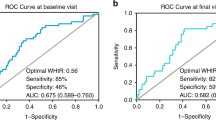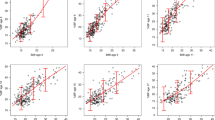Abstract
Objective:
Several studies suggest that taller children may be wrongly labelled as ‘overweight’ because body mass index (BMI) is not independent of height (Ht) in childhood, and recommend adjustment to render the index Ht independent. We used objective measures of %body fat and hormonal/metabolic markers of fatness to investigate whether BMI and the corresponding fat mass index (FMI) mislead in childhood, or whether taller children really are fatter.
Design:
Longitudinal observational study measuring children annually from age 7 to 12 years.
Subjects:
Two hundred and eighty healthy children (56% boys) from the EarlyBird study.
Measurements:
BMI (body mass (BM)/Ht2), FMI (fat mass (FM)/Ht2), %body fat ((FM/BM) × 100, where FM was measured by dual-energy X-ray absorptiometry), fasting leptin (a hormonal measure of body fatness) and insulin resistance (a metabolic marker derived from the validated homeostasis model assessment program for insulin resistance - HOMA2-IR) were all analysed in relation to Ht. Alternative Ht-independent indices of BM and FM were compared with BMI and FMI as indicators of true fatness and related health risk.
Results:
BMI and FMI correlated with Ht at each annual time point (r∼0.47 and 0.46, respectively), yet these correlations were similar in strength to those between Ht and %fat (r∼0.47), leptin (r∼0.41) and insulin resistance (r∼0.40). Also, children who grew the most between 7 and 12 years showed greater increases in BMI, FMI, leptin and insulin resistance (tertile 1 vs 3, all p<0.05). BMI and FMI explained ∼20% more of the variation in %fat, ∼15% more in leptin and ∼10% more in insulin resistance than the respective Ht-independent reformulations (BM/Ht3.5 and FM/Ht7, both p<0.001).
Conclusion:
Taller children really are fatter than their shorter peers, have higher leptin levels and are more insulin resistant. Attempts to render indices of BM or FM independent of Ht in children seem inappropriate if the object of the index is to convey health risk.
This is a preview of subscription content, access via your institution
Access options
Subscribe to this journal
Receive 12 print issues and online access
$259.00 per year
only $21.58 per issue
Buy this article
- Purchase on Springer Link
- Instant access to full article PDF
Prices may be subject to local taxes which are calculated during checkout
Similar content being viewed by others

References
Quetelet A . Development of stature, weight, strength and of the development of the weight, and of its relations to development of the height of the body. In: Treatise on Man, and the Development of His Faculties. William and Robert Chambers: Edinburgh, UK, 1842, pp 63–67. (Reprinted in 1968, Burt Franklin, NY, USA).
Colditz GA, Willett WC, Stampfer MJ, Manson JE, Hennekens CH, Arky RA et al. Weight as a risk factor for clinical diabetes in women. Am J Epidemiol 1990; 132: 501–513.
Chan JM, Rimm EB, Colditz GA, Stampfer MJ, Willett WC . Obesity, fat distribution, and weight gain as risk factors for clinical diabetes in men. Diabetes Care 1994; 17: 961–969.
Cole TJ, Freeman JV, Preece MA . Body mass index reference curves for the UK, 1990. Arch Dis Child 1995; 73: 25–29.
Cole TJ . Weight/heightp compared to weight/height2 for assessing adiposity in childhood: influence of age and bone age on p during puberty. Ann Hum Biol 1986; 13: 433–451.
Franklin M . Comparison of weight and height relations in boys from 4 countries. Am J Clin Nutr 1999; 70: 157S–162S.
Frontini MG, Bao W, Elkasabany A, Srinivasan SR, Berenson G . Comparison of weight-for-height indices as a measure of adiposity and cardiovascular risk from childhood to young adulthood: the Bogalusa heart study. J Clin Epidemiol 2001; 54: 817–822.
Hattori K, Hirohara T . Age change of power in weight/height(p) indices used as indicators of adiposity in Japanese. Am J Hum Biol 2002; 14: 275–279.
Telford RD, Cunningham RB . Reformulation of BMI and percent body fat to remove the height bias in 8-year-olds. Obesity (Silver Spring) 2008; 16: 2175–2181.
Benn RT . Some mathematical properties of weight-for-height indices used as measures of adiposity. Br J Prev Soc Med 1971; 25: 42–50.
Wells JC, Cole TJ . Adjustment of fat-free mass and fat mass for height in children aged 8 y. Int J Obes Relat Metab Disord 2002; 26: 947–952.
Voss LD, Kirkby J, Metcalf BS, Jeffery AN, O’Riordan C, Murphy MJ et al. Preventable factors in childhood that lead to insulin resistance, diabetes mellitus and the metabolic syndrome: the EarlyBird diabetes study 1. J Pediatr Endocrinol Metab 2003; 16: 1211–1224.
Sopher AB, Thornton JC, Wang J, Pierson Jr RN, Heymsfield SB, Horlick M . Measurement of percentage of body fat in 411 children and adolescents: a comparison of dual-energy X-ray absorptiometry with a four-compartment model. Pediatrics 2004; 113: 1285–1290.
Schoppen S, Riestra P, Garcia-Anguita A, Lopez-Simon L, Cano B, de O et al. Leptin and adiponectin levels in pubertal children: relationship with anthropometric variables and body composition. Clin Chem Lab Med 2010; 48: 707–711.
Levy JC, Matthews DR, Hermans MP . Correct homeostasis model assessment (HOMA) evaluation uses the computer program. Diabet Care 1998; 21: 2191–2192.
Gungor N, Saad R, Janosky J, Arslanian S . Validation of surrogate estimates of insulin sensitivity and insulin secretion in children and adolescents. J Pediatr 2004; 144: 47–55.
Twisk JWR . Other possibilities for modelling longitudinal data. In: Twisk JWR (ed). Applied Longitudinal Data Analysis for Epidemiology: A Practical Guide. Cambridge University Press: Cambridge, MA, 2003, pp 102–119.
Biro FM, Wien M . Childhood obesity and adult morbidities. Am J Clin Nutr 2010; 91: 1499S–1505S.
Gale CR, Javaid MK, Robinson SM, Law CM, Godfrey KM, Cooper C . Maternal size in pregnancy and body composition in children. J Clin Endocrinol Metab 2007; 92: 3904–3911.
Hawkesworth S, Prentice AM, Fulford AJ, Moore SE . Dietary supplementation of rural Gambian women during pregnancy does not affect body composition in offspring at 11–17 years of age. J Nutr 2008; 138: 2468–2473.
Elks CE, Loos RJ, Sharp SJ, Langenberg C, Ring SM, Timpson NJ et al. Genetic markers of adult obesity risk are associated with greater early infancy weight gain and growth. PLoS Med 2010; 7: e1000284.
Agostoni C, Grandi F, Gianni ML, Silano M, Torcoletti M, Giovannini M et al. Growth patterns of breast fed and formula fed infants in the first 12 months of life: an Italian study. Arch Dis Child 1999; 81: 395–399.
Acknowledgements
We thank Karen Brookes and Val Morgan for their assistance with data collection and Sharan Griffin and Geraldine Pearce for operating the dual-energy X-ray absorptiometry machine. The EarlyBird Diabetes Study is funded by Diabetes UK, Bright Futures Trust, Smith's Charity, Child Growth Foundation, Diabetes Foundation, Beatrice Laing Trust, Abbott, Astra-Zeneca, GSK, Ipsen, Roche. None of the sources funding this study had any involvement in the study design, collection or analysis of data, interpretation of findings or writing of the manuscript.
Author information
Authors and Affiliations
Corresponding author
Ethics declarations
Competing interests
The authors declare no conflict of interest.
Rights and permissions
About this article
Cite this article
Metcalf, B., Hosking, J., Frémeaux, A. et al. BMI was right all along: taller children really are fatter (implications of making childhood BMI independent of height) EarlyBird 48. Int J Obes 35, 541–547 (2011). https://doi.org/10.1038/ijo.2010.258
Received:
Accepted:
Published:
Issue Date:
DOI: https://doi.org/10.1038/ijo.2010.258
Keywords
This article is cited by
-
Sexual dimorphism of leptin and adiposity in children between 0 and 10 years: a systematic review and meta-analysis
Biology of Sex Differences (2022)
-
Identifying metabolic syndrome in migrant Asian Indian adults with anthropometric and visceral fat action points
Diabetology & Metabolic Syndrome (2022)
-
Further reductions in the prevalence of obesity in 4-year-old New Zealand children from 2017 to 2019
International Journal of Obesity (2022)
-
The effect of height on estimates of the change in BMI-based prevalence of childhood obesity
International Journal of Obesity (2021)
-
Height, adiposity and hormonal cardiovascular risk markers in childhood: how to partition the associations?
International Journal of Obesity (2014)


